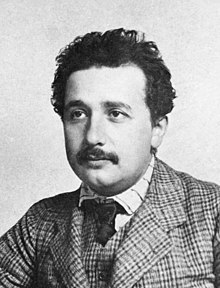
Back Spesiale relatiwiteit Afrikaans Spezielle Relativitätstheorie ALS ልዩ አንጻራዊነት Amharic Relatividat especial AN النسبية الخاصة Arabic نسبيه خاصه ARZ বিশেষ আপেক্ষিকতাবাদ তত্ত্ব Assamese Teoría de la relatividá especial AST Xüsusi nisbilik nəzəriyyəsi Azerbaijani اؤزل نیسبیت AZB

| Special relativity |
|---|
 |
In physics, the special theory of relativity, or special relativity for short, is a scientific theory of the relationship between space and time. In Albert Einstein's 1905 paper, On the Electrodynamics of Moving Bodies, the theory is presented as being based on just two postulates:[p 1][1][2]
- The laws of physics are invariant (identical) in all inertial frames of reference (that is, frames of reference with no acceleration). This is known as the principle of relativity.
- The speed of light in vacuum is the same for all observers, regardless of the motion of light source or observer. This is known as the principle of light constancy, or the principle of light speed invariance.
The first postulate was first formulated by Galileo Galilei (see Galilean invariance).
Cite error: There are <ref group=p> tags on this page, but the references will not show without a {{reflist|group=p}} template (see the help page).
- ^ Griffiths, David J. (2013). "Electrodynamics and Relativity". Introduction to Electrodynamics (4th ed.). Pearson. Chapter 12. ISBN 978-0-321-85656-2.
- ^ Jackson, John D. (1999). "Special Theory of Relativity". Classical Electrodynamics (3rd ed.). John Wiley & Sons. Chapter 11. ISBN 0-471-30932-X.